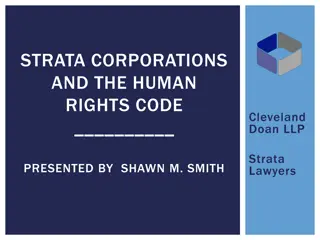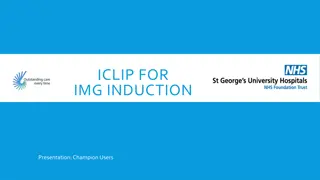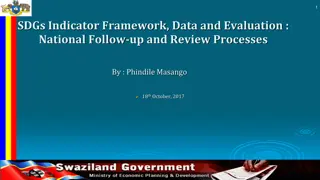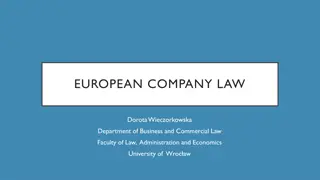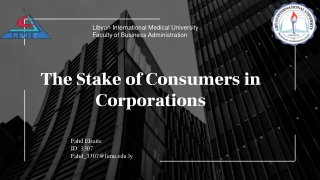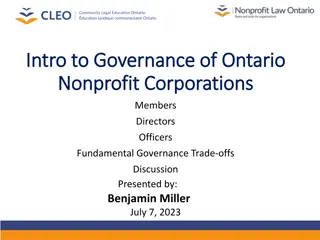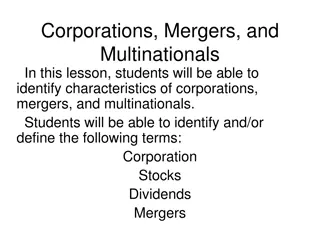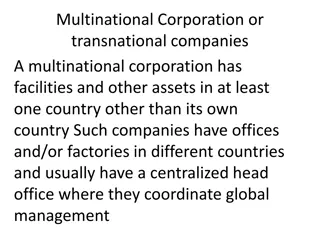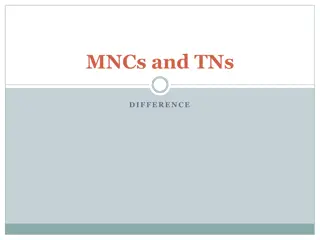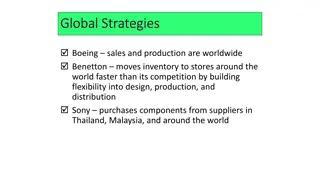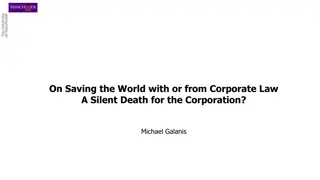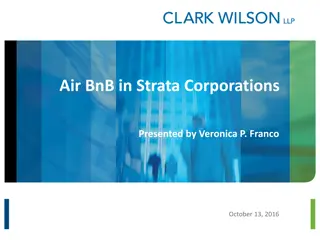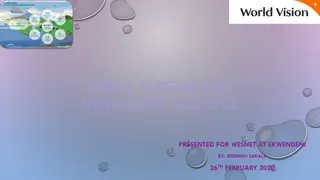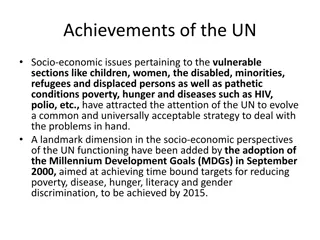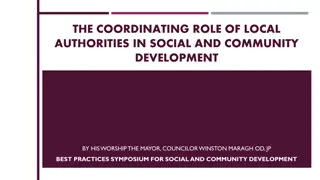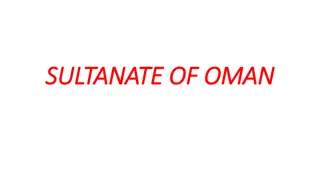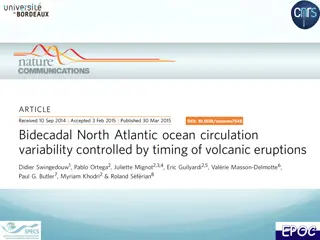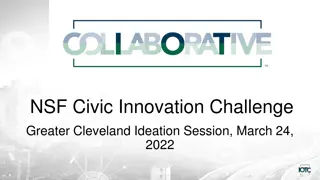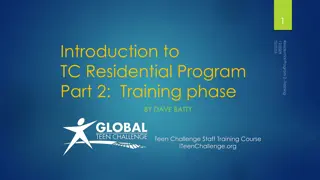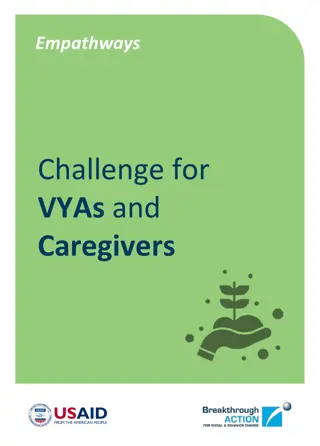Overview of Millennium Challenge Corporation's Compact Development Process
The Millennium Challenge Corporation (MCC) works to reduce poverty through economic growth in select developing countries. MCC's Compact Development Process involves identifying constraints to private investment and economic growth, conducting analyses, and implementing large-scale projects within 5-year grants. The process is overseen by the Millennium Challenge Coordinating Unit (MCCU) established by the government, which monitors performance to meet MCC indicators.
- Millennium Challenge Corporation
- Compact Development
- Economic Growth
- Development Projects
- Constraint Analysis
Download Presentation

Please find below an Image/Link to download the presentation.
The content on the website is provided AS IS for your information and personal use only. It may not be sold, licensed, or shared on other websites without obtaining consent from the author. Download presentation by click this link. If you encounter any issues during the download, it is possible that the publisher has removed the file from their server.
E N D
Presentation Transcript
INITIAL CONSULTATIONS ON THE CONSTRAINT ANALYSIS DRAFT REPORT JULY 2013
Agenda 1) Introduction: The Millennium Challenge Corporation 2) Introduction: Millennium Challenge Coordinating Unit 101 1) MCC s Approach to Identifying Projects - Constraints Analysis, Social and Gender Assessment and Investment Opportunity Analysis 2) Preliminary Findings of Constrains Analysis Likely Binding Constraints 3) [Preliminary Findings of Social and Gender Assessment] 4) Discussion Sessions
Introduction: MCC WHAT IS MCC? The Millennium Challenge Corporation (MCC) is a U.S. Government agency designed to reduce poverty through economic growth in select developing countries.
What is a Compact? MCC Compacts are . 5-year agreement grants between MCC and a partner country to support agreed development objectives through an integrated set of projects and activities and must be implemented within 5 years Awarded to eligible countries as determined by MCC s eligibility criteria and final vote of the MCC Board of Directors Typically large-scale and complex projects/activities Over $7 billion awarded as compact grants to 25 partner countries worldwide Implemented by the partner country government with guidance and oversight from MCC Examples of MCC funded activities include Agriculture, Water & Sanitation Infrastructure, Healthcare Infrastructure, Education, Microfinance, Policy Reforms etc
MCCU 1. MCCU is the body established by Government with the responsibility to drive the Compact Development Process up to the signing of the compact 2. MCCU is therefore responsible for developing the Constraints Analysis, Social & Gender Analysis, and the Investment Opportunity Analyses 3. MCCU is also responsible for monitoring the performance of Government with respect to the MCC indicators
MCCs Approach to Identifying Projects Compact developments starts with an analysis phase Partner countries conduct rigorous analyses to identify binding constraints to private investment and economic growth 3 pillars of analysis phase: Constraints analysis Social and gender analysis Investment opportunity assessment
Constraints Analysis What is a Constraints Analysis? What does it do? Data-driven analysis of entire domestic economy Prioritizes concerns that most impede economic growth Binding constraints to growth High demand, but low supply Does not provide answers or solutions Provides useful framework for public consultations Requires further analysis to reach specific project ideas Based on 2005 study by economists from Harvard, World Bank Analytical framework that examines impediments to economic growth Seeks to identify factors that impede private investment and growth Low private returns High costs of capital Uses a decision tree to guide analysis
Social and Gender Analysis Identifies issues that impact intended beneficiaries (different social groups including the poor, women, disabled) in a specific sector, region or context Assesses legal, policy, institutional and socio- cultural aspects of binding constraints, and related issues that can disadvantage certain groups in the country Goal: To ensure projects deliver maximum benefits to targeted populations and ensure that access to opportunities are equitable (men, women, other potentially disadvantaged groups)
Investment Opportunity Analysis Identifies and develops opportunities to promote private sector investment in or around potential compact investments Goal: To enhance economic impact and sustainability of compact projects through private sector investment; i.e. what happens after a constraint is removed
Stages of the Compact Development Process ? 5 stages in the Compact Development Process 1. Analysis Conducts CA to economic growth, opportunities for private investment, and social and gender analysis to poverty reduction 2. Project Definition Develops project proposals around the binding constraints 3. Project Definition & Appraisal Prepares detailed project proposals 4. Compact Negotiation & Signing 5. Preparation for Entry into Force Establishes the Millennium Challenge Account entity that implements the projects
Methodology ? The CA is based on the HRV methodology developed by Harvard Economists ? The CA looked at what Investment and Entrepreneurship in Sierra Leone Cost of Finance and/or Returns to Economic Activity ? COST OF FINANCE 1.International Finance 2.Domestic Finance ? RETURNS TO ECONOMIC ACTIVITY 1.Social Returns 2.Private Appropriability and World Bank constraints Private
Methodology Cont. Social Returns Natural Capital Natural Resources Infrastructure Power, Water & Sanitation, Roads, ICT Human Capital Accumulation Education & Health Private Appropriability Market Failure in Innovation Micro Risks Property rights, corruption, taxes, Regulatory quality Macro Risks Inflation, fiscal stability, public debt etc. 1. ? ? ? 2. ? ? ?
Methodology Cont. ? The CA hinges on four tests, namely; 1.Shadow Price Test 2.Growth Test 3.Circumvention Test 4.Non reliance Test
Preliminary Findings: Access to Electricity As A Binding Constraint
High Power Outages Area Unit of Measurement Sierra Leone LICs (Fragile States) LICs (Non Fragile States) Access (National) % of Population 7.0 15.0 33.0 Access (Urban) % of Population 35.0 57.6 86.0 Access (Rural) % of Population 3.9 4.0 4.1 Power Outages No. of Days 46 11.0 10.0 Generation Capacity MW per Million People 13.0 46.0 20.0 Electricity Consumption KWH per Capita 14.0 165.0 107.0 ? The estimated cost of these outages to the economy was approximately US$ 17 Million or 0.7 percent of the GDP for 2009.
High Power Tariffs and Unmet Demand Has one of the highest power tariffs in the sub region High demand (236MW) and low supply (78.5MW), hence High Unmet Demand 157.5MW
Households demand for Generator has Increased ..this signals high level of circumvention by households
Percent of firms owning or sharing a generator has increased Percent of Firms Owning or Sharing a Generator Country Country Average Firms The Gambia 20.7 15.2 Guinea 59.9 60.6 Sierra Leone 81.8 80.7 Malawi 25.3 Liberia 66.5 67.1 Year Small Medium Firms Large Firms 25.7 47.3 n.a. 82.9 2006 2006 86.4 34.4 52.9 100 46.0 94.3 2009 2009 2009 4.1 .this also shows a lot of firms are trying to bypass the constraint
Large number of firms identified electricity as a major constraint to their business
Why is Power therefore a binding constraint to growth There is High Power Outage (46 days) about 4 times higher than the average in LICs and costs about 0.7% of GDP in 2009 There is High Unmet demand for Power - High Demand for Power (236 MW) and Low Supply (78.5 MW) High Level of Circumvention Households and Firms through an Increased use of Generator Large number of businesses identified lack of electricity as a major business by both constraint to their
Preliminary Findings: Access to Rural and/or Secondary Roads As A Binding Constraint
The Quality of Sierra Leones Road network is among the Comparative Analysis of Quality of Roads (2012) poorest in Africa Country Quality Index Ranking: Over 144 Sierra Leone Ethiopia Gambia Ghana Guinea Malawi Rwanda Liberia Pakistan 2.8 4.1 4.5 3.5 2 3.4 5 3.8 3.9 116 64 51 85 140 89 40 76 73
Inaccessibility of Rural Roads Rural roads are inaccessible for at least two months (approximately 16 percent) of the year during the peak of the rains
High Transport Costs in Unpaved than Paved Roads ? This also imply that transport costs are high in rural areas where there are more unpaved roads than urban areas where there are more of paved roads
High Transport Cost Globally Due to bad roads, Sierra Leone has high Transport and Maintenance Costs
A Good Investment on Road Network would Increase the Volume of Trade ? A Road Network facilitates the distribution of agricultural produce; movement of goods and services etc.
A Good Investment on Road Network would Increase the Volume of Trade Country Investments (Million US $) Current Change (%) Network Upgraded (Km) Change in Trade (%) Upgraded Guinea 727 165.1 246.2 924 96.3 2,733 2,077 127 64 Mali 149.9 67.5 19.5 307.1 115.2 33.5 473.2 47.7 14.0 166.1 4,239 609 1964 71 72 54 Ethiopia Sierra Leone Senegal Equatorial Guinea South Africa 35.6 526 17.0 109 48 2500 60228 35228 8655 141
Increased Use of Okadas Due to the inaccessibility of majority of the road network, Okada s has increased over the years the demand for
Why is Road therefore a Binding Constraint ? Very Poor Road Network Quality Among the worst in Sub Saharan Africa ? High Levels of Inaccessibility Rural Roads ? High Transportation and Maintenance Costs ? An Increased Investment on Road Network will Improve Trade and hence Growth ? High Level of Circumvention indicated by the increased demand for OKADA s especially
Access to Water and Sanitation As A Binding Constraint
Low supply of water and sanitation especially in rural areas
Low supply of water and sanitation and in comparison to neighboring countries and the region
There is high demand for water, even unmet demand Due to wastages, distributional and institutional (GUMA & SALWACO) problems
Costs of low water and sanitation supply?; Why is this a constraint to growth? High demand and low supply Firms/households pay a high price for water; water is expensive Removing the constraint would lead to increased growth or productivity High health care expenses from water borne disease and lost productivity caring for self or others Lost time collecting water; impacts wages and firm productivity People are trying to get around the constraint Using unsafe water sources, especially in rural areas
Low supply of water and sanitation as a binding constraint Summary: Households spending time and money because of low supply of water and sanitation Constraints Analysis estimate of total economic cost = approximately USD $93 per year per household This includes: Cost of water + Health expenses + Value of time lost to illness and water collection Possible Impact on Women and Youth: Women and Youth spend a lot of their productive time to collect and use water for cooking and other household work Women are also mostly responsible for care of the sick in the family Added burden on women which can impact their health, time to engage on productive contribution to economic growth. activities and limiting their
Preliminary Findings: Policy and Institutional Effectiveness As A Binding Constraint
Large Informal Sector ? According to 2006 IFC/World Bank survey of informal sector in Sierra: 86% say the high cost and burden of licenses 75% say the tax burden 36% of completely informal businesses know nothing about the procedures for formalization in their area of business, and another 40% only know a few detail ? Failure to formalize: 27% found it too costly 26% found the steps too complicated 22% were unable to find the necessary information
Taxes ? Doing Business estimates 33 payments per year 357 hours per year Driven largely by Social Security (12 payments, 168 hours, 10% rate) and GST (12 payments, 174 hours, 15% rate) ? Businesses can save up to 25% and about 40 days per year on taxes alone by remaining informal
Effects of tax inefficiencies ? Policy ineffectiveness leads to institutional ineffectiveness More informal firms require more revenue agents to try to collect taxes Low tax revenue as a percentage of GDP is shown in CA Lower tax revenue leads to more borrowing or reduced spending on needs such as infrastructure (also shown in CA)
Not just Taxes but a Restrictive Land Tenure System ? Majority of the 40% of agricultural land for production is found outside the capital ? The land tenure system in Sierra Leone has to a large extent restricted investments ? The restriction to land ownership both by foreign nationals and constraints investments especially because majority of large investments are mostly foreign owned. Traditionally, women do not own land and landed property restricting access and security of tenure leaving them vulnerable to poverty. non indigenes
Sierra Leone Ranks Low in her ability to lease land to foreigners and non indigenes Indicators Country Score IAB Regional Average IAB Global Average Strength of lease rights index (0- 100) 44.4 76.6 82.1 Access to land information index (0-100) 26.3 33.9 41.4 Availability of land information index (0-100) 30 58.5 70.6 Time to lease private land (in days) 210 72 61 Time to lease public land (in days) 277 151 140
The Process of Registering Property is tedious Since the Process is Cumbersome, the Associated Costs are HIGH
Not just Taxes and Land, but also Government Parastatals ? NPA, SLRA and GVWC cannot maintain infrastructure because of institutional ineffectiveness) inefficiencies (institutional Source: Pushak and Foster, 2011 ?
Why is Institutional and Policy Effectiveness a possible binding Constraint ? Large informal sector Pays too many taxes (33 payments in a year) hence evades tax and payment of Social Security ? The Land Tenure Investments (both internationally with access) ? It takes on average about 240 days (8 months) to lease a land ? Sierra Leone is among the worst performers in registering a property ? NPA, SLRA, GVWC,SIERRATEL maintain infrastructure institutional inefficiencies collection inefficiencies and losses. System domestically women has deterred and least having etc cannot because Underpricing, of
Conclusion ? From the available data and analysis made, the following conclusions can be made: As a post conflict country, Sierra Leone s growth has averaged 5% per year Private investments, growth, have been considerably low due to a number of factors Identified four likely binding constraints to private investments Power, Rural roads, Water and Sanitation, Institutional Effectiveness. which should propel and Policy and
THANKS ? QUESTIONS AND CONTRIBUTIONS



